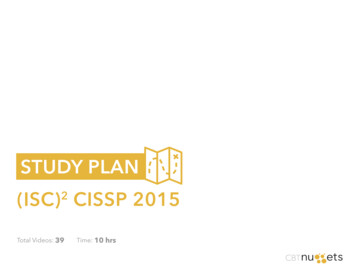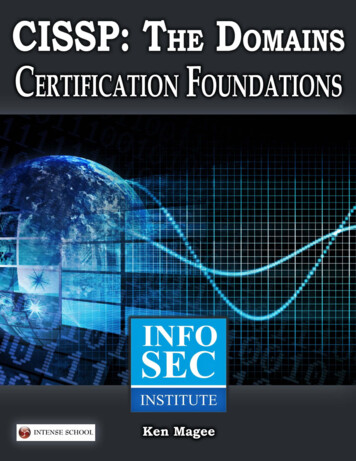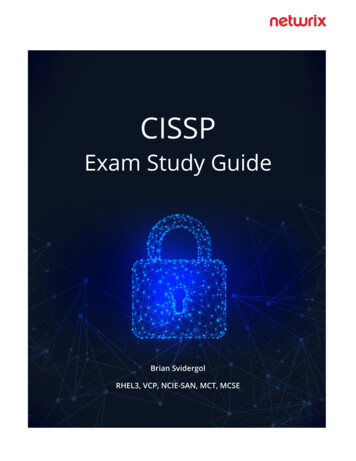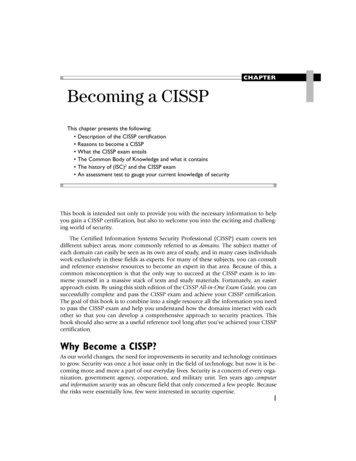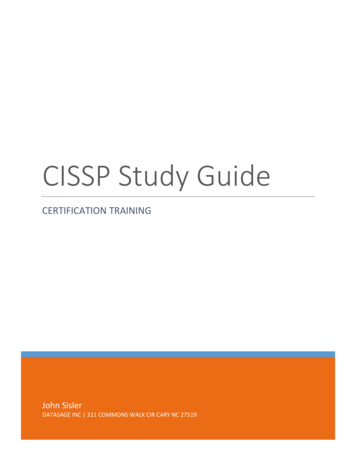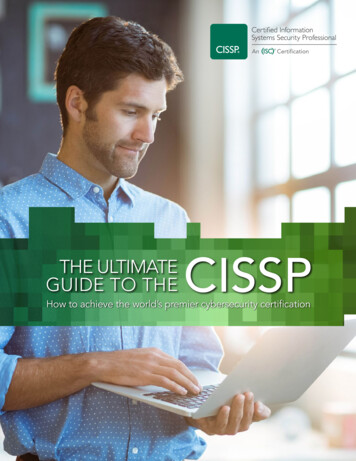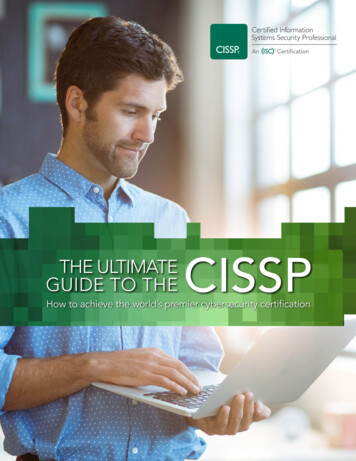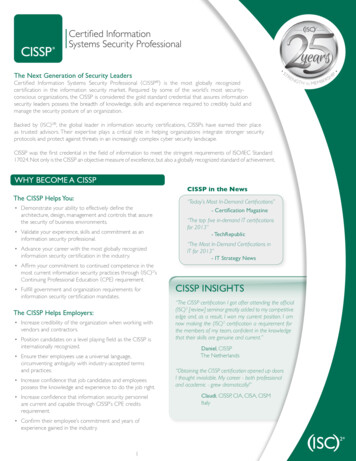
Transcription
00 0789740303 fm.qxd11/23/0911:04 AMPage iCISSP Video MentorShon HarrisPearson Education, Inc.800 East 96th Street Indianapolis, IN 46240
00 0789740303 fm.qxd11/23/0911:43 AMPage iiCISSP Video MentorCopyright 2010 by Pearson Education, Inc.All rights reserved. No part of this book shall be reproduced, stored in aretrieval system, or transmitted by any means, electronic, mechanical, photocopying, recording, or otherwise, without written permission from the publisher. No patent liability is assumed with respect to the use of the information contained herein. Although every precaution has been taken in the preparation of this book, the publisher and author assume no responsibility forerrors or omissions. Nor is any liability assumed for damages resulting fromthe use of the information contained herein.ISBN-13: 978-0-7897-4030-4ISBN-10: 0-7897-4030-3Printed in the United States of AmericaFirst printing December 2009TrademarksAll terms mentioned in this book that are known to be trademarks or servicemarks have been appropriately capitalized. Pearson cannot attest to the accuracy of this information. Use of a term in this book should not be regarded asaffecting the validity of any trademark or service mark.Warning and DisclaimerEvery effort has been made to make this book as complete and as accurate aspossible, but no warranty or fitness is implied. The information provided ison an “as is” basis. The author and the publisher shall have neither liabilitynor responsibility to any person or entity with respect to any loss or damagesarising from the information contained in this book or from the use of the CDor programs accompanying it.Bulk SalesPearson offers excellent discounts on this book when ordered in quantity forbulk purchases or special sales. For more information, please contactU.S. Corporate and Government or sales outside the U.S., please contactInternational Salesinternational@pearsoned.comPublisherPaul BogerAssociate PublisherDavid DusthimerAcquisitions EditorJessica GoldsteinDevelopment EditorAndrew CuppManaging EditorPatrick KanouseTechnical EditorShawn MerdingerCopy EditorWater Crest PublishingPublishing CoordinatorVanessa EvansMultimedia DeveloperDan ScherfDesignerGary AdairPage LayoutBronkella Publishing LLC
00 0789740303 fm.qxd11/20/099:23 AMPage iiiContents at a GlanceLesson 1 Cryptography FoundationsLesson 2 Symmetric Versus Asymmetric AlgorithmsLesson 3 Hashing and Message Authentication CodesLesson 4 IPSec and Its ConfigurationsLesson 5 OSI Model and ProtocolsLesson 6 802.11 Wireless
00 0789740303 fm.qxd11/20/099:23 AMPage iv
00 0789740303 fm.qxd11/20/099:23 AMPage vContentsIntroduction1Lesson 1Cryptography Foundations3Encryption, Decryption, and Cryptosystems . . . . . . . . . . . . . . . . . . . . . . . . . . . . . . . . 4Encryption Algorithms and Keys . . . . . . . . . . . . . . . . . . . . . . . . . . . . . . . . . . . . . . . . . . . . . . 4Key Management . . . . . . . . . . . . . . . . . . . . . . . . . . . . . . . . . . . . . . . . . . . . . . . . . . . . . . . . . 6Key and Key Management Rules . . . . . . . . . . . . . . . . . . . . . . . . . . . . . . . . . . . . . . 8Summary . . . . . . . . . . . . . . . . . . . . . . . . . . . . . . . . . . . . . . . . . . . . . . . . . . . . . . . . . . . . . . . . . . . . . . . . . . 8Lesson 2Symmetric Versus Asymmetric Algorithms9Symmetric Cryptography . . . . . . . . . . . . . . . . . . . . . . . . . . . . . . . . . . . . . . . . . . . . . . . . . . . . . 10Asymmetric Cryptography . . . . . . . . . . . . . . . . . . . . . . . . . . . . . . . . . . . . . . . . . . . . . . . . . . . . 11Hybrid Encryption Methods . . . . . . . . . . . . . . . . . . . . . . . . . . . . . . . . . . . . . . . . . . . . . . . . . . 13Summary . . . . . . . . . . . . . . . . . . . . . . . . . . . . . . . . . . . . . . . . . . . . . . . . . . . . . . . . . . . . . . . . . . . . . . . . . 14Lesson 3Hashing and Message Authentication Codes15The One-Way Hash . . . . . . . . . . . . . . . . . . . . . . . . . . . . . . . . . . . . . . . . . . . . . . . . . . . . . . . . . . . . 15Message Authentication Code . . . . . . . . . . . . . . . . . . . . . . . . . . . . . . . . . . . . . . . . . . . . . . . 16Hash MAC . . . . . . . . . . . . . . . . . . . . . . . . . . . . . . . . . . . . . . . . . . . . . . . . . . . . . . . . . . . . . . . . 17Cipher Block Chaining MAC . . . . . . . . . . . . . . . . . . . . . . . . . . . . . . . . . . . . . . . . . . 18Types of Hashing Algorithms . . . . . . . . . . . . . . . . . . . . . . . . . . . . . . . . . . . . . . . . . . . . . . . . . 18Hash Function Attacks . . . . . . . . . . . . . . . . . . . . . . . . . . . . . . . . . . . . . . . . . . . . . . . . . . . . . . . . . 19An Example . . . . . . . . . . . . . . . . . . . . . . . . . . . . . . . . . . . . . . . . . . . . . . . . . . . . . . . . . . . . . . 19Summary . . . . . . . . . . . . . . . . . . . . . . . . . . . . . . . . . . . . . . . . . . . . . . . . . . . . . . . . . . . . . . . . . . . . . . . . . 20Lesson 4IPSec and Its Configurations21Virtual Private Networks. . . . . . . . . . . . . . . . . . . . . . . . . . . . . . . . . . . . . . . . . . . . . . . . . . . . . . . 22Tunneling Protocols . . . . . . . . . . . . . . . . . . . . . . . . . . . . . . . . . . . . . . . . . . . . . . . . . . . . . . . . . . . . 23PPTP . . . . . . . . . . . . . . . . . . . . . . . . . . . . . . . . . . . . . . . . . . . . . . . . . . . . . . . . . . . . . . . . . . . . . . . 23L2TP . . . . . . . . . . . . . . . . . . . . . . . . . . . . . . . . . . . . . . . . . . . . . . . . . . . . . . . . . . . . . . . . . . . . . . . 24IPSec . . . . . . . . . . . . . . . . . . . . . . . . . . . . . . . . . . . . . . . . . . . . . . . . . . . . . . . . . . . . . . . . . . . . . . 24Tunneling Protocols At-a-Glance . . . . . . . . . . . . . . . . . . . . . . . . . . . . . . . . . . . . . 26Summary . . . . . . . . . . . . . . . . . . . . . . . . . . . . . . . . . . . . . . . . . . . . . . . . . . . . . . . . . . . . . . . . . . . . . . . . . 27
00 0789740303 fm.qxdvi11/20/099:23 AMPage viContentsLesson 5OSI Model and Protocols29Open Systems Interconnection Reference Model . . . . . . . . . . . . . . . . . . . . . . . . 29Application Layer . . . . . . . . . . . . . . . . . . . . . . . . . . . . . . . . . . . . . . . . . . . . . . . . . . . . . . . 31Presentation Layer . . . . . . . . . . . . . . . . . . . . . . . . . . . . . . . . . . . . . . . . . . . . . . . . . . . . . . 31Session Layer . . . . . . . . . . . . . . . . . . . . . . . . . . . . . . . . . . . . . . . . . . . . . . . . . . . . . . . . . . . . 32Transport Layer . . . . . . . . . . . . . . . . . . . . . . . . . . . . . . . . . . . . . . . . . . . . . . . . . . . . . . . . . . 33Network Layer . . . . . . . . . . . . . . . . . . . . . . . . . . . . . . . . . . . . . . . . . . . . . . . . . . . . . . . . . . . 34Data Link Layer . . . . . . . . . . . . . . . . . . . . . . . . . . . . . . . . . . . . . . . . . . . . . . . . . . . . . . . . . . 34Physical Layer . . . . . . . . . . . . . . . . . . . . . . . . . . . . . . . . . . . . . . . . . . . . . . . . . . . . . . . . . . . . 35Summary . . . . . . . . . . . . . . . . . . . . . . . . . . . . . . . . . . . . . . . . . . . . . . . . . . . . . . . . . . . . . . . . . . . . . . . . . 36Lesson 6802.11 Wireless37Wireless Communications . . . . . . . . . . . . . . . . . . . . . . . . . . . . . . . . . . . . . . . . . . . . . . . . . . . . . 37Wireless LAN Components . . . . . . . . . . . . . . . . . . . . . . . . . . . . . . . . . . . . . . . . . . . . . . . . . . . 38Wireless Standards . . . . . . . . . . . . . . . . . . . . . . . . . . . . . . . . . . . . . . . . . . . . . . . . . . . . . . . . . . . . . 39802.11b . . . . . . . . . . . . . . . . . . . . . . . . . . . . . . . . . . . . . . . . . . . . . . . . . . . . . . . . . . . . . . . . . . . 39802.11a . . . . . . . . . . . . . . . . . . . . . . . . . . . . . . . . . . . . . . . . . . . . . . . . . . . . . . . . . . . . . . . . . . . 40802.11e . . . . . . . . . . . . . . . . . . . . . . . . . . . . . . . . . . . . . . . . . . . . . . . . . . . . . . . . . . . . . . . . . . . 40802.11f . . . . . . . . . . . . . . . . . . . . . . . . . . . . . . . . . . . . . . . . . . . . . . . . . . . . . . . . . . . . . . . . . . . . 40802.11g . . . . . . . . . . . . . . . . . . . . . . . . . . . . . . . . . . . . . . . . . . . . . . . . . . . . . . . . . . . . . . . . . . . 40802.11h . . . . . . . . . . . . . . . . . . . . . . . . . . . . . . . . . . . . . . . . . . . . . . . . . . . . . . . . . . . . . . . . . . . 41802.11i . . . . . . . . . . . . . . . . . . . . . . . . . . . . . . . . . . . . . . . . . . . . . . . . . . . . . . . . . . . . . . . . . . . . 41802.11n . . . . . . . . . . . . . . . . . . . . . . . . . . . . . . . . . . . . . . . . . . . . . . . . . . . . . . . . . . . . . . . . . . . 42802.16 . . . . . . . . . . . . . . . . . . . . . . . . . . . . . . . . . . . . . . . . . . . . . . . . . . . . . . . . . . . . . . . . . . . . . 42802.15 . . . . . . . . . . . . . . . . . . . . . . . . . . . . . . . . . . . . . . . . . . . . . . . . . . . . . . . . . . . . . . . . . . . . . 42Bluetooth Wireless . . . . . . . . . . . . . . . . . . . . . . . . . . . . . . . . . . . . . . . . . . . . . . . . . . . . . . 43Summary . . . . . . . . . . . . . . . . . . . . . . . . . . . . . . . . . . . . . . . . . . . . . . . . . . . . . . . . . . . . . . . . . . . . . . . . . 43
00 0789740303 fm.qxd11/20/099:23 AMPage viiAbout the AuthorShon Harris, CISSP, is the president of Logical Security, a security consultant, a former engineerin the Air Force’s Information Warfare unit, an instructor, and an author. She has authored twobest-selling CISSP books and was a contributing author to the books Hacker’s Challenge and GrayHat Hacking. Shon was recognized as one of the top 25 women in the Information Security fieldby Information Security Magazine.
00 0789740303 fm.qxd11/20/099:23 AMPage viiiAbout the ContributorsCrystal Bedell is a copywriter specializing in technology. She has 10 years of experience writingand editing study guides and articles for information technology professionals in security and networking. In addition, she writes B2B technology marketing materials such as white papers, casestudies, and e-books. She offers marketing communications support and advice through her website, www.bedellcommunications.com.Don Keeber is a solutions-oriented networking and security engineer with notable success delivering a broad range of corporate IT initiatives, while participating in planning and implementation ofinformation-security solutions in direct support of business objectives.Although most of Don’s career has been on the delivery side, a significant segment was in a technical training role, during which he conducted classes for scores of IT professionals from severalFortune-500 organizations. The training programs were corporate-based certification tracks forCheck Point Firewalls, RSA Security, and Nokia Security Specializations.Don’s current technical certifications include: (ISC)2 CISSP #318146, Cisco CCSP, CCNP, CCDP,and CCIE-security (written only), Microsoft MCSE-2003 Security, Checkpoint CCSE/CCSI NG/NGX, RSA-SE/Instructor, INFOSec (NSA) Security Specialist, Novell CNE, BluecoatBlueNet, and CompTIA CTT (written part).Michael J. Lester holds a master’s degree in information systems security from Boston University(an NSA Center of Excellence), as well as around 20 industry certifications including CISSP,CISA, CCE #876, Security , MCSE:Security, CCSE , and ITIL. He is an author of Gray HatHacking: The Ethical Hacker’s Handbook (McGraw Hill Publishing), a book on advanced penetration-testing techniques, and has written many other articles and presentations. He is the chiefinstructor for Shon Harris’s Logical Security LLC, and he teaches and develops courses on CISSP,hacking and penetration testing, digital forensics and eDiscovery, CISA, and others. He is currently teaching, consulting, and authoring a book on digital forensics.About the Technical EditorShawn Merdinger is an independent security researcher and consultant. In former corporate lives,he’s worked with the Cisco Systems STAT Team and TippingPoint ZDI, as well as non-profitAustin FreeNet. His research in security has led to multiple CVE vulnerabilities, presenting atsecurity conferences, and involvement with VOIPSA, the Voice Over IP Security Association. Hiscurrent research focuses on medical device security, with more information at the LinkedInMedSec group.
00 0789740303 fm.qxd11/20/099:23 AMPage ixDedicationFor Dad.AcknowledgmentsI want to thank the Pearson group for their patience with me to get this product out. They aresaints!
00 0789740303 fm.qxd11/20/099:23 AMPage xWe Want to Hear from You!As the reader of this book, you are our most important critic and commentator. We value youropinion and want to know what we’re doing right, what we could do better, what areas you’d liketo see us publish in, and any other words of wisdom you’re willing to pass our way.As an Associate Publisher for Pearson, I welcome your comments. You can email or write medirectly to let me know what you did or didn’t like about this book—as well as what we can do tomake our books better.Please note that I cannot help you with technical problems related to the topic of this book. We dohave a User Services group, however, where I will forward specific technical questions related tothe book.When you write, please be sure to include this book’s title and author as well as your name, emailaddress, and phone number. I will carefully review your comments and share them with the authorand editors who worked on the book.Email:feedback@quepublishing.comMail:David DusthimerAssociate PublisherPearson800 East 96th StreetIndianapolis, IN 46240 USAReader ServicesVisit our website and register this book at informit.com/register for convenient access to anyupdates, downloads, or errata that might be available for this book.
01 0789740303 book.qxd11/20/099:23 AMPage 11IntroductionThe CISSP Video Mentor includes six lesson videos and seven lab videos, as follows: Lesson 1, “Cryptography Foundations” Lesson 2, “Symmetric Versus Asymmetric Algorithms” Lab 2-1: Public and Private Key Generation Lab 2-2: PGP Encryption and Signing Lab 2-3: Symmetric Encryption Lesson 3, “Hashing and Message Authentication Codes” Lab 3-1: Hashing and Message Authentication Codes Lesson 4, “IPSec and Its Configurations” Lab 4-1: IPSec with Windows Vista Lesson 5, “OSI Model and Protocols” Lab 5-1: Networking and the OSI Model Lesson 6, “802.11 Wireless” Lab 6-1: Configuring 802.11 WiFiThe lesson videos provide a conceptual understanding of some of the most important topics for theCISSP exams. The lab videos provide a more technical in-depth understanding of these CISSPexam concepts. The goal of this product is to help prepare you for the stringent and most soughtafter security certification in the industry. The product also contains this booklet, which is supplemental to the content in the lesson videos. The goal of this booklet is to connect the conceptualitems to the more technical topics in this product.
01 0789740303 book.qxd11/20/099:23 AMPage 2
01 0789740303 book.qxd11/20/099:23 AMPage 31Cryptography FoundationsIn this first lesson, you acquire a foundational knowledge necessary for understanding cryptography.We then build on that foundation to explore security services offered by different cryptography methods, cryptosystem components, and encryption and decryption processes. This chapter reinforces whatyou learn in the Lesson 1 video. Cryptography constitutes an entire domain within the (ISC)2Common Body of Knowledge, and it is necessary for you to understand these concepts going into theexam.The term cryptography comes from the Greek kryptos, meaning “hidden, secret,” and grapho, meaning “I write.” Even in ancient times, people understood the value of protecting sensitive informationby making it unreadable. We’ve made many advances in cryptography, and today it is considered ascience. Cryptography is the practice of storing and sending data in a form that is unreadable by anyone and any process except those for which it is intended. Valuable information is protected by encoding it so that others cannot read or process it. Thus, cryptography is an effective method of protectingsensitive data both at rest and while it is transmitted over untrusted network communication paths.Cryptography DefinitionsThere are a lot of terms thrown around in any discussion of cryptography. In order to fully graspthe technology—and pass the CISSP exam—you must understand the following definitions:Access control—Restricting and controlling access attempts made by subjects and objects.Algorithm—A set of mathematical and logical rules that dictate how enciphering and decipheringtake place in an encryption method.Cryptanalysis—The practice of breaking cryptosystems.Cryptography—The science of storing and sending data in a form that is unreadable by anyoneand any process except those for which it is intended.Cryptology—The study of cryptography and cryptanalysis.Cryptosystem—A system or hardware that carries out the process of encrypting and decryptingdata.Data origin authentication—Also known as system-based authentication, proving a message’ssource.Decipher—Transforming ciphertext back into plaintext.Encipher—Transforming data into ciphertext.Entity authentication—Proving the identity of the sender of a message.Key—A secret sequence of bits that dictates encryption and decryption.Work factor—The time, effort, and resources necessary to break a cryptosystem.
01 0789740303 book.qxd411/20/099:23 AMPage 4CISSP Video MentorEncryption, Decryption, and CryptosystemsInformation that can be read by humans or processed by a computer is referred to as plaintext. Forexample, a human can read a document in plaintext and a computer can process executable code inplaintext. Through a process called encryption, plaintext is transformed into ciphertext. Ciphertextappears to be random and cannot be understood by humans or computer systems. Because ciphertext cannot be deciphered until it is decrypted, the data is protected against unauthorized disclosure. This is particularly important when sending data over untrusted networks. When data isstored on computers, it is usually protected by logical and physical access controls. However, datais in a much vulnerable state when sent over networks that may not be protected.The process of transforming ciphertext back into readable plaintext is called decryption. Thiswhole process of encrypting and decrypting data is carried out by a cryptosystem. A cryptosystemcan be a system or a product that is created through hardware components or program code in anapplication. PGP is an example of one popular cryptosystem available commercially, with GnuPGavailable as a free implementation of the OpenPGP standard. Cryptosystems can provide a numberof services. By transforming plaintext into ciphertext and making it unintelligible by anyone oranything except for authorized recipients, a cryptosystem provides confidentiality. If a cryptosystem can ensure that data has not been modified in an unauthorized manner since it was created,transmitted, or stored, it provides integrity. Authentication services confirm the identity of the useror system that created the information. Authorization involves proving a user or service’s identityand then providing that entity with access to the information. And finally nonrepudiation keeps thesender from denying that she sent the message. In order to make the whole encryption/decryptionprocess happen, cryptosystems make use of an encryption algorithm, keys (also called cryptovariables), and various software components and protocols. Let’s look at each of these in greaterdetail.Encryption Algorithms and KeysAn encryption algorithm (also called a cipher) is a set of mathematical rules that dictate how enciphering and deciphering take place. The more complex the mathematics, the more complex theencryption process. However, the internal mechanisms of most algorithms in use today are publicly known. If the algorithm used by a cryptosystem is not a secret, something else must be: thekey. The key is a value that comprises a sequence of random bits that is used by the algorithm toencrypt and decrypt data. This value is secret. You can think about it this way: The lock on thefront door of your home is not the only one of its kind. The manufacturer has probably sold hundreds of thousands of that same lock. However, that doesn’t mean that your neighbor, Bill, whohas the same lock, can let himself into your house. Bill has a unique key to his lock, as do you,and every other owner of that lock. The key is the secret that keeps the lock secure.So if an eavesdropper intercepts an encrypted message, all she can see is ciphertext. She may beable to determine what algorithm is being used and how that algorithm works, but that knowledgealone will not help her decrypt the message. She must have the key.In encryption, a key is constructed by the algorithm, which contains a keyspace. A keyspace is arange of values that can be used to create a key. The larger an algorithm’s keyspace, the greater the
01 0789740303 book.qxd11/20/099:23 AMPage 5Lesson 1: Cryptography Foundations5number of values that can be used to create different keys. The greater the number of values, themore random the keys. And the more random the keys, the more difficult they are to uncover.Keeping in mind that we are working in binary and that 22 equals 4, consider a key length of 2bits. The keyspace for the associated algorithm would be 4. So four different keys are possible.This small keyspace would not be very difficult to crack because there are few values to choosefrom. An attacker could easily determine the key value and use it to decrypt ciphertext. However, alarge keyspace allows for more possible keys. As long as the encryption algorithm uses the entirekeyspace and randomly chooses the values that make up the key, it will be more difficult to decipher.NoteCryptanalysis is the science of studying and breaking encryption methods. This includes breaking secret processes, such as key management; compromising authentication schemes; andreverse-engineering algorithms. Cryptanalysis can be carried out by both well-intentionedgood guys as well as malicious attackers. Security researchers use cryptanalysis to identifyflaws and weaknesses in cryptosystems and encryption methods so that they can be improvedupon. This is an important piece of cryptography and cryptology if our methods are evergoing to improve. However, when attackers use cryptanalysis to find weaknesses in cryptosystems, it is for the purpose of exploiting them to gain unauthorized access to confidential information.When we discuss how easily a key can be cracked, we’re talking about its strength. Strength canalso be discussed in terms of the algorithm if it is not public. In fact, the overall strength of anencryption method comes from a variety of components: the secrecy and length of the key, thealgorithm, the initialization vectors, and how they work together in the cryptosystem. The encryption method’s strength corresponds to the processing power, resources, and time that must be dedicated to breaking the cryptosystem or cracking the key. When attackers attempt to break cryptosystems, they often execute a brute force attack on the key. This involves exhaustively attemptingevery combination of possible values until the right combination is uncovered. The difficulty ofaccomplishing this task is a reflection of the encryption method’s strength.An algorithm’s strength also comes from its use of initialization vectors (IVs), random values thathelp prevent patterns from occurring during the encryption process. When used with keys, IVsensure that two identical plaintext values (for example, a phrase such as “I love you”) encryptedwith the same key will not produce the same ciphertext. If IVs are not used, patterns can be detected in the ciphertext, making it easier for an attacker to break the encryption method and the key.The IV, along with the key, provides more randomness to the encryption process, thereby strengthening it. However, although some keys must be kept secret, it is not necessary for an IV to be keptprivate, and it therefore does not need to be encrypted when transmitted.As you can see, there are several components that play a role in the strength of an algorithm orcipher. There are two main types of ciphers: block and stream. A stream cipher encrypts individualbits, whereas a block cipher encrypts blocks of bits. Block ciphers are commonly implemented atthe software level because they require less processing power. Stream ciphers, on the other hand,require more randomness and processing power, making them more suitable for hardware-levelencryption.
01 0789740303 book.qxd11/20/099:23 AMPage 6CISSP Video Mentor6A strong stream cipher is characterized by the following: Long portions of bit patterns without repeating patterns within keystream values. Thekeystream must generate random bits. A keystream independent of the key. An attacker should not be able to determine the keyvalue based on the keystream. An unpredictable keystream. The keystream must generate statistically unpredictable bits. An unbiased keystream. There should be as many 0s as there are 1s in the keystream.Neither should dominate.Key ManagementA cryptosystem’s ability to provide confidentiality, integrity, and authentication hinges on the security of the keys. If the keys are compromised, the entire system could be compromised. It won’tmatter how complicated and complex the algorithm is.Cryptography is a trust model based on keys. Users must trust one another to protect their ownkeys. They must trust the server that holds, maintains, and distributes keys. And they must trust theadministrator in charge of key management. This is a lot to ask, considering keys can be captured,altered, corrupted, or disclosed to unauthorized individuals in the absence of proper precautions.It should go without saying, then, that key management is a crucial part of cryptography.Unfortunately, it also tends to be the Achilles heel. Using keys to encrypt messages is just the tipof the key management iceberg. Fortunately, automation can be used to help with the many aspectsof key management, which include ensuring the secure distribution of keys to the correct entities,continuously updating keys, ensuring their protection while in transit and while stored on workstations and servers, and ensuring that they are properly created, destroyed, and recovered.Most keys are distributed today using a protocol via an automated process, relieving individualsfrom this task. However, that wasn’t always the case. At one time, physical cryptographic keyswere stored in secured boxes. An escorted courier was responsible for delivering them and, sometimes, distributing them to individual computers. Other times, the courier would deliver the keys toa main server and local administration would then distribute them to individual machines. In someimplementations, a master key delivered by the courier would be used to generate unique secretkeys for individual users. The fact that the courier was escorted emphasizes the need to transmitkeys in a secure manner.An example of automated key distribution is the Key Distribution Center (KDC) used by Kerberos(Kerberos is an authentication protocol that builds on symmetric key cryptography to enable networked systems to securely authenticate to one another). The KDC stores, distributes, and maintains session and secret keys. When Computer A wants to access a service on Computer B,Computer A submits its request to the KDC. The KDC then creates a session key that is usedbetween the two computers. Automation reduces the potential for errors that can occur whenhumans are involved with manual processes. However, if the KDC’s ticket-granting service (TGS)is compromised, all computers and their services are impacted and possibly compromised as well.
01 0789740303 book.qxd11/20/099:23 AMPage 7Lesson 1: Cryptography Foundations7All this effort to securely distribute keys is for naught if the keys are carelessly stored by theirrecipients. That brings us to the next hurdle in key management: Keys must be securely storedbefore and after they are distributed to the proper entities. Keys should not be kept just anywhereon a user’s desktop but instead should be securely placed within the file system where they can bestored and used in a controlled fashion. A module containing the key, algorithm, configurations,and parameters also needs to be protected. If an attacker gets a hold of any one of these components, she can use them to decrypt, read, and re-encrypt information not intended for her. In fact,anytime a key is stored outside the cryptosystem, it should be in ciphertext. Because many algorithms are publicly understood, it is important that the secret component of the cryptosystem—thekey—be protected. If an attacker knows which algorithm a system is using and how that algorithmworks, all she needs is the key to compromise the cryptographic system.Secure storage of the user’s key, as well as the other processes associated with key management,should be transparent to the user. They can be integrated into software and operating systems sothat they are automated and hidden from the user. Depending on end users to perform theseprocesses only asks for trouble. It adds complexity to the process and increases the possibility oferrors being introduced or the processes not getting done at all.Keys also need to be continually changed. This is one task that when manually
Shon Harris, CISSP, is the president of Logical Security, a security consultant, a former engineer in the Air Force’s Information Warfare unit, an instructor, and an author. She has authored two best-selling CISSP books and was a contributing author to the books Hacker’s Challengeand Gr
